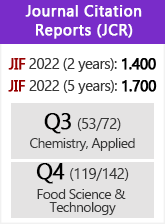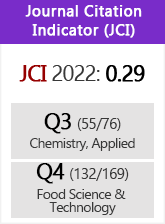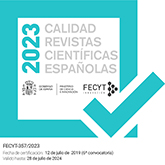Quantitative and qualitative variation of the fatty acid composition in the dinoflagellate Crypthecodinium cohnii under nitrogen starvation conditions
DOI:
https://doi.org/10.3989/gya.2008.v59.i1.486Keywords:
Crypthecodinium cohnii, DHA, Fatty acids, Heterotrophic cultureAbstract
Crypthecodinium cohnii is a heterotrophic dinoflagellate that can achieve a lipid content greater than 20% on dry weight. DHA can represent up to 40% of the total fatty acids. Our objective was to investigate the variation in fatty acid content when growth conditions are optimal compared with when there is limited growth, due to the absence of nitrogen in the media. Nitrogen-limited growth conditions caused the cells to stop dividing and accumulate lipids, principally as docohexanoic acid (DHA). Oxygen availability in the culture favoured DHA accumulation. In the cultures without nitrogen and with oxygen availability there was a lipid cell content 3,18 times higher than in the control condition (with nitrogen and air), and 2,25 higher than those without nitrogen and air. C. cohnii can be used as an optimal DHA source for the production of phytodiets in aquaculture.
Downloads
References
Barclay WR, Meager KM y Abril JR. 1994. Heterotrophic production of long Caín omega-3 fatty acids ultilizing algae and algae-like microorgansims. J. Appl. Phycol. 6, 123-129. doi:10.1007/BF02186066
Beach DH y Holz GG. 1973. Enviromental influencies on the docosahexaenoate content of the triacylglycero and phosphatidylcholine of heterotropbic, marine dinoflagellate Crypthecodinium cohnii. Biochimica et biophysica acta Amsterdam 316 (1) 56-65.
De la Jara A, Mendoza H, Martel A, Molina C, Nordströn L, de la Rosa V y Díaz R. 2003. Flow cytometric determination of lipid content in marine dinoflagellate, Crypthecodinium cohnii. J. Appl. Phyco.l 15, 433-438. doi:10.1023/A:1026007902078
Folch S, Lee M y Stanley GHS. 1957. A simple method for the isolation and purification of total lipids from animal tissues. J. Biol. Chem.226, 497-504.
Guillard RRL. 1975. Culture of phytoplankton of feeding marine invertebrates. Plenum Press, New York.
Harel M, Koven W, Lein I, Yoav B, Behrens P, Stubblefield J, Zohar Y y Place A. 2002. Advanced DHA, EPA and ArA enrichments materials for marine aquaculture using single cells heterotrophs. Aquaculture 213, 347-362. doi:10.1016/S0044-8486(02)00047-9
Henderson RJ, Letfley JW y Sargent JR. 1988. Lipid composition and biosynthesis in the marine dinoflagellate Crypthecodinium cohnii. Phytochemistry 27 (6) 1679-1683. doi:10.1016/0031-9422(88)80425-4
Hinzpeter I, Shene C y Massa L. 2006. Alternativas biotecnológicas para la producción de ácidos grasos poliinsaturados omega-3. Grasas Aceites 57 (3) 336-342.
Jiang Y, Cheng F, Liang SZ. 1999. Producción potental of docosahexaenoic acid by the hetrotrophic marine dinoflagellate Crypthecodinium cohnii. Process Biochem. 34, 633-637. doi:10.1016/S0032-9592(98)00134-4
Jiang Y y Cheng F. 2000. Effects of medium glucose concentration and pH on docohexaenoic acid content of hetrotrophic Crypthecodinium cohnii. Process Biochem. 35, 1205-1209. doi:10.1016/S0032-9592(00)00163-1
Kessell RHJ. 1968. Fatty acids of Rhodotorula gracilis: fat production in sumerged culture and particular affect of pH value. J. Appl. Bacteriol. 31, 220-231.
Molina Grima E, Belarbi EH, Fernández FGA, Robles Medina A y Chisti Y. 2003. Recovery of microalgal biomass and metabolites: process options and econimics. Biotechnol. Adv. 20, 491-515. doi:10.1016/S0734-9750(02)00050-2
Muller-Feuga A. 2000. The role of microalgae in aquaculture: situation and trends. J. Appl. Phycol. 12, 527-534. doi:10.1023/A:1008106304417
Petkov GD, Klyachko-Gurvich GL, Furnadzhieva ST, Pronina NA y Ramazanov ZM. 1990. Genotypic differences and phenotypic changes of lipid fatty acid composition in strains of Dunaliella salina. Soviet Planta Physiol. 3, 268-272.
Pulz O y Cross W. 2004. Valuable products from biotechnology of microalgae. J. Appl. Microbiol. Bitechnol. 65, 635-648. doi:10.1007/s00253-004-1647-x
Radmer RJ y Parker BC. 1994. Commercial applications of algae: opportunities and contraints. J. Appl. Phycol. 6, 93-98. doi:10.1007/BF02186062
Ratledge C y Evans CT. 1989. Lipids and their metabolism. 2nd Ed., Academic Press. Londres.
Reed D, Brzezinski MA, Coury DA, Graham WM y Petty RL. 1999. Neutral lipids in macroalgae spores and their role in swimming. Marine Biology 133, 737-744. doi:10.1007/s002270050515
Reitan KI, Rainuzo JR y Olsen Y. 1994. Effect of nutient limitation of fatty acid and lipid content of marine microalge. J. Phycol. 30, 972-979. doi:10.1111/j.0022-3646.1994.00972.x
Richmon A. 2000. Microalgal biotechnology at the turn of the millenium: a personal view. J. Appl. Phycol. 12, 441-451. doi:10.1023/A:1008123131307
Rodriguez C, Pérez JA, Badia P, Izquierdo MS, Fernández Palacios H y Hernández L. 1998. The n-3 highly unsaturated fatty acids requirements of gilthead seabream (Spaurus aurata L.) larvae when using an appropriate DHA/EPA ratio in the diet. Aquaculture. 169, 9-23. doi:10.1016/S0044-8486(98)00328-7
Roessler PG. 1990. Environmental control of glycerolipid metabolism in microalgae: commercial implications and future research directions. J. Phycol. 26, 393-399. doi:10.1111/j.0022-3646.1990.00393.x
Sargent J, Bell G, McEvoy L, Toucher D y Estévez A. 1999. Recent developments in the essential fatty acid nutrition of fish. Aquaculture 177, 191-199. doi:10.1016/S0044-8486(99)00083-6
Swaaf ME. 2003. Docohexaenoic acid production by marine alga Crypthecodinium cohnii . University Press. Netherlands.
Swaaf ME, de Rijk TC, Egingk G y Syjtsma L. 1999. Optimisation of docohexaenoic acid production in batch cultivations by Crypthecodinium cohnii. J. Biotechnol. 70, 185-192. doi:10.1016/S0168-1656(99)00071-1
Downloads
Published
How to Cite
Issue
Section
License
Copyright (c) 2008 Consejo Superior de Investigaciones Científicas (CSIC)

This work is licensed under a Creative Commons Attribution 4.0 International License.
© CSIC. Manuscripts published in both the printed and online versions of this Journal are the property of Consejo Superior de Investigaciones Científicas, and quoting this source is a requirement for any partial or full reproduction.All contents of this electronic edition, except where otherwise noted, are distributed under a “Creative Commons Attribution 4.0 International” (CC BY 4.0) License. You may read here the basic information and the legal text of the license. The indication of the CC BY 4.0 License must be expressly stated in this way when necessary.
Self-archiving in repositories, personal webpages or similar, of any version other than the published by the Editor, is not allowed.
















